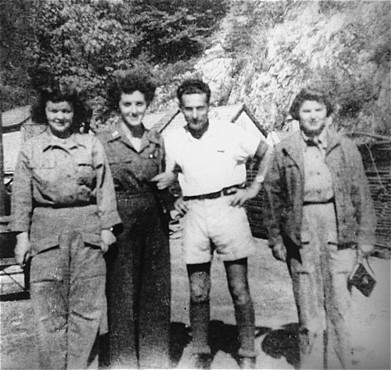Counterfeit money printed at Sachsenhausen In the photograph above, one of the Jewish prisoners who made counterfeit money for the Nazis at the Sachsenhausen concentration camp is shown with three American Army nurses. Left to right, Lt. Mary Beggs, Lt. Julia Davis, Adolf Burger, and Lt. Ada Timmer. The photo was taken at Ebensee, a sub-camp of the Mauthausen Concentration Camp in Austria after the camp was liberated by American soldiers in May 1945. The printing of counterfeit money at Sachsenhausen was code-named Operation Bernhard, in honor of the man who directed the operation, SS Major Bernhard Krüger. This was a Nazi scheme, begun in 1942, to wreak havoc by bombarding the British economy with millions of counterfeit Bank of England pound notes in denominations of 5, 10, 20 and 50. The Nazis had 100 German agents abroad who were putting these fake bills into circulation. The printing press in the Sachsenhausen camp produced 8,965,080 bank notes which had a value of 134,610,810 British pounds, or $377 million in American dollars. The men who carried out the work of engraving the fake bills included Jewish inmates who were brought to Sachsenhausen because they possessed skills in typography and forging documents. Nine Jewish prisoners at Auschwitz (five Polish, one Dutch, one French, one Czech and one stateless) were selected on March 10, 1944 to go to Sachsenhausen where they were put to work in Operation Bernhard. One of the experts on the team of 142 counterfeiters was Salamon Smolianoff, a Russian who had been forging English 50-pound notes as early as 1927 and had been arrested and jailed in Amsterdam for counterfeiting. Another was Adolf Burger, a Slovakian Jew who had been trained as a printer. After Hitler invaded Czechoslovakia in 1939, Slovakia became a separate fascist country and an ally of Germany. Until he was arrested by the Slovak Gestapo in the summer of 1942, Burger worked in a printing plant in Bratislava where he forged citizenship papers, birth certificates and other documents for the underground Communists. He was sent to Auschwitz where he was forced to work as a slave laborer until he was sent to Sachsenhausen to work with Operation Bernhard. According to Adolf Burger, who wrote a book about his experiences, the forgers at Sachsenhausen also successfully copied the U.S. $100 bill. He said that the first 200 fake American bills were finished on February 22, 1945 and that the printing presses were scheduled to start printing the first million dollars in American money the next day. But this never happened, as an order from the Reich Security main office ordered the work to stop and the machinery to be dismantled. When Sachsenhausen was evacuated in April 1945, the Operation Bernhard team was transferred to Ebensee, a sub-camp of the Mauthausen concentration camp in Austria where they were liberated by the American Army on May 5, 1945. After he was liberated, Burger settled in Prague in what is now the Czech Republic and in September 1945, he published an 86-page book in the Czech language, entitled "Cislo 64401 mluvi" (Number 64401 Speaks). Number 64401 was the number tattooed on his arm by the SS at Auschwitz. These numbers were used to keep track of the prisoners and their special skills on IBM punch cards, which is how the SS knew that Burger was an experienced printer. Later, Burger published another book entitled Des Teufels Werkstatt (The Devil's Workshop) in Communist East Germany. After the fall of Communism, this book became a best seller, but it was never translated into English. In 1988, an East German television station produced a 45-minute documentary based on his book. A more extensive memoir by the Norwegian printer, Moritz Nachstern, written in 1949 when his memory was fresh, has just been re-published by Spartacus Press in Norway. The publisher, Frode Molven, can be contacted via e-mail at frode@spartacus.no and the book may be purchased online. A new book by Lawrence Malkin, entitled
"Krueger's Men: The Secret Nazi Counterfeit Plot and the
Prisoners of Block 19," was published in the Fall of 2006
by Little, Brown in the USA and in Germany as "Hitlers Geldfaelscher"
by Luebbe. The book is based on three years of research in a
number of countries and is far more comprehensive than Burger's
memoir. More information about this new book can be found at
the author's web site at www.lawrencemalkin.com.
The book contains reproductions of around 50 secret documents
about the counterfeit plot and what happened to the money. Lawrence
Malkin, the author, has a personal connection to the story which
is explained in the dedication of the book and in a footnote
on page 99. Tour of the Sachsenhausen Memorial SiteTable of ContentsHome
|